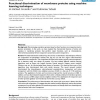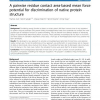6 search results - page 1 / 2 » Application of amino acid occurrence for discriminating diff... |
BMCBI
2007
2007
Application of amino acid occurrence for discriminating different folding types of globular proteins
13 years 4 months ago
Background: Predicting the three-dimensional structure of a protein from its amino acid sequence is a long-standing goal in computational/molecular biology. The discrimination of ...
BMCBI
2008
13 years 4 months ago
2008
Background: Discriminating membrane proteins based on their functions is an important task in genome annotation. In this work, we have analyzed the characteristic features of amin...
BMCBI
2007
13 years 4 months ago
2007
Background: Protein remote homology detection is a central problem in computational biology. Most recent methods train support vector machines to discriminate between related and ...
BMCBI
2010
13 years 4 months ago
2010
Background: Considering energy function to detect a correct protein fold from incorrect ones is very important for protein structure prediction and protein folding. Knowledge-base...
BMCBI
2008
13 years 4 months ago
2008
Background: Recent approaches for predicting the three-dimensional (3D) structure of proteins such as de novo or fold recognition methods mostly rely on simplified energy potentia...


